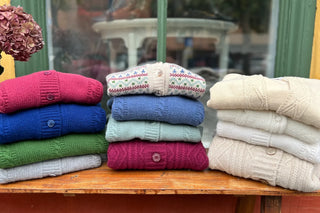Why Proper Wool Care Matters
Wool is one of nature’s most remarkable fibres. It’s soft, breathable, temperature-regulating, and incredibly durable when cared for correctly. Our vintage-inspired knitwear is made from high-quality, luxuriously soft Italian merino wool and mohair, carefully crafted within the EU. With the right care, your favourite woollen pieces can last for many years, ageing beautifully over time.
 Astrid is one of my classic vintage-inspired wool cardigans, shown here in a beautiful mélange brown shade.
Astrid is one of my classic vintage-inspired wool cardigans, shown here in a beautiful mélange brown shade.
1. How Often Should You Wash Wool? (Hint: Not Often!)
When people ask how often they should wash their wool jumpers, our honest answer is: you probably don’t need to. Wool contains lanolin, a natural wax that repels dirt, odours, and bacteria, meaning frequent washing is unnecessary and can even cause damage.
Instead, try airing your wool garments. Simply hang them outside for a few hours; damp or misty weather works wonders for freshening wool. Alternatively, hang them in the bathroom while you shower. The steam helps revive the fibres and smooth out wrinkles.
2. How to Wash Wool Garments the Right Way
When a wash is truly needed, for instance, to remove a stubborn stain or lingering odour, it’s important to handle your wool gently. Always follow the care label, but here are our best general tips:
-
Hand wash in lukewarm water (maximum 30°C).
-
Use a mild detergent formulated specifically for wool.
-
If using a washing machine, select the wool or hand-wash cycle with a low spin.
-
Never wring or twist your garment; instead, gently press out excess water while it lies flat on a towel.
Hot water, vigorous spinning, or harsh detergents can damage the fibres and strip away wool’s natural properties.
 Gertrud, my vintage-inspired pullover in a vibrant green shade, is perfect for an everyday autumn outfit.
Gertrud, my vintage-inspired pullover in a vibrant green shade, is perfect for an everyday autumn outfit.
3. The Best Way to Dry Wool and Knitwear
After washing, wool should always be dried flat. Lay your garment on a clean towel, reshape it gently to its original form, and allow it to air dry away from direct heat or sunlight. Replace the towel if it becomes damp.
Avoid hanging wet knitwear, as gravity can stretch the fibres. Tumble drying will cause shrinkage and dryness.
Once completely dry, your jumper may feel slightly snug at first, but don’t worry. It will quickly relax and shape to your body again as you wear it.
 The Fair Isle pattern is a classic design often seen in 1940s cardigans. Rosemary is my take on a Fair Isle wool cardigan.
The Fair Isle pattern is a classic design often seen in 1940s cardigans. Rosemary is my take on a Fair Isle wool cardigan.
4. How to Prevent and Remove Pilling from Wool Jumpers
It’s natural for wool garments to pill a little at first. When wool is spun, shorter fibres sometimes work their way to the surface, especially in areas exposed to friction (such as sleeves or underarms).
To remove pills:
-
Use a fabric shaver or pilling comb, gliding it gently over the surface.
-
Avoid sticky lint rollers, as they can pull out fibres and cause further pilling.
-
A soft clothes brush is ideal for removing dust and keeping the surface smooth.
5. Caring for Mohair Knitwear
Mohair, known for its lightness and lustrous texture, benefits from occasional washing to reduce shedding and maintain its fluffy structure. Wash gently as described above and, once dry, brush lightly with a soft, natural-bristle brush to restore its delicate halo-like finish.
 My mohair cardigan Lisbeth works perfectly as a light summer jacket.
My mohair cardigan Lisbeth works perfectly as a light summer jacket.
6. Wool Garments Stretch Over Time - Here’s How to Fix It
Because wool is a natural fibre, your jumper may stretch slightly over time. To restore its original shape, simply wash and dry it flat, following the recommended steps above.
7. Washing Instructions for Wool Tights
For years, it has been difficult to find warm, unique, vintage-style tights for women, which is why we decided to create our own wool tights: The Anita Tights. They’re the perfect match for your vintage-inspired outfit.
Made from a soft and warm wool blend, they feature a delicate 1940s-style knit pattern.
Composition: 80% extra-fine merino wool, 17% polyamide, 3% elastane.
-
Wash inside out before first use to strengthen the fibres.
-
Machine wash at 30°C on a delicate cycle.
-
Air dry only. Do not bleach, tumble dry, iron, or dry clean.
 My Anita Tights are based on an original pair of 1940s stockings. Here they’re shown with my 1940s Emily oxfords.
My Anita Tights are based on an original pair of 1940s stockings. Here they’re shown with my 1940s Emily oxfords.
8. Washing Instructions for Cotton Socks
Our classic Matilda Bobby Socks are made of cotton and based on an original 1940s design. They offer both comfort and flexibility for everyday wear.
Composition: 80% cotton, 17% polyamide, 3% elastane.
-
Wash inside out before first use.
-
Machine wash at 40°C on a delicate cycle.
-
Air dry only.
 My feminine Matilda Ankle Socks are inspired by the teenage fashions of the 1930s, 1940s, and 1950s. Here they’re shown with Grace, a pair of 1940s two-tone shoes.
My feminine Matilda Ankle Socks are inspired by the teenage fashions of the 1930s, 1940s, and 1950s. Here they’re shown with Grace, a pair of 1940s two-tone shoes.
Final Wool Care Tips for Long-Lasting Knitwear
Wool is a living, breathing fibre, and when treated with care, it rewards you with warmth, comfort, and longevity. Treat your knitwear gently, wash sparingly, and store it well.
If you ever have questions about caring for your garments, please don’t hesitate to contact us. We’re always happy to help.
I hope you enjoy your Memery knitwear for many years to come.
Mette 💕

Want to learn how to care for your leather shoes and boots? Check out our guide for tips on keeping your favorite footwear looking great for years to come: How to Clean Leather Shoes and Boots.
If you own a pair of suede shoes, don’t worry, we’ve got you covered too. Discover how to keep them in top condition here: How to Clean Suede Shoes.


